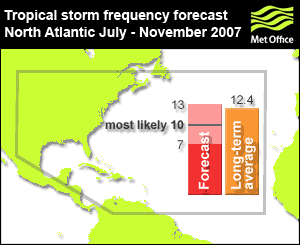North Atlantic tropical storm seasonal forecast 2007
Tropical storm seasonal forecast for the July to November period
Forecast for July to November 2007
Issued 19 June 2007
Ten tropical storms are predicted as the most likely number to occur in the North Atlantic during the July to November period, with a 70% chance that the number will be in the range 7 to 13. This represents below normal activity relative to the 1990-2005 long-term average of 12.4.
Note: The forecast is for the five full months remaining in the June-November Atlantic tropical storm season. There have already been two named storms - Andrea and Barry.

More information?
A detailed report with information on probabilities and the strength and credibility of signals within the forecast is produced alongside the headline storm number prediction each season.
Download the 2007 report.
Background
A tropical cyclone is the generic term for a low-pressure system over tropical or sub-tropical waters, with organised convection (i.e. thunderstorm activity) and winds at low levels, circulating either anti-clockwise in the northern hemisphere or clockwise in the southern hemisphere. A tropical storm is a tropical cyclone with mean wind speeds of at least 39 m.p.h. The terms hurricane and typhoon are regionally-specific names for a strong tropical cyclone with wind speeds of at least 74 m.p.h.
The number of tropical storms forming over the North Atlantic is influenced by sea-surface temperatures (SST), over both the tropical Atlantic, and the tropical Pacific.
| 2002 | 2003 | 2004 | 2005 | 2006 |
|---|---|---|---|---|
| 12 | 13 | 15 | 25 | 9 |
Method
At the start of every North Atlantic season (which usually runs from June to November) the Met Office forecasts the number of tropical storms expected throughout the period. This is done using a dynamical seasonal prediction computer model of the global atmosphere-ocean system called Met Office seasonal prediction system: GloSea4.
The forecast is based on GloSea representation of dynamical and physical processes characteristic of tropical storms. This is done by counting the frequency of tropical storms in the model forecasts. However, as the dynamical model grid does not fully resolve tropical storms, numbers are calibrated using tropical storm behaviour in past forecasts. The forecast process also includes predictions of the sea-surface temperature (SST) anomalies. This season, a cooling trend in SST is expected in the tropical North Atlantic, and this favours fewer tropical storms than seen in recent years prior to 2006 (see the table)
Verification
During the 2007 Atlantic season there was a total of 12 named storms in the July-November time frame. The Met Office forecast issued in June predicted 10 storms with a 70% probability range of 7-13.
To view PDF documents you will need to download Adobe Reader




